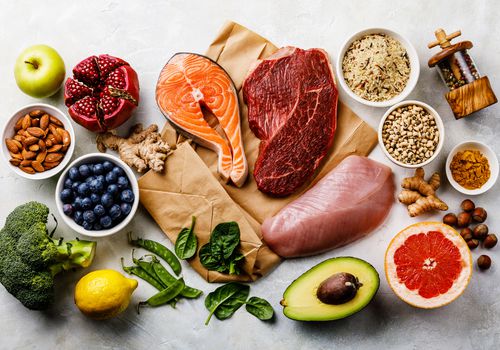There are many reasons for working out and eating properly. However, the two most popular reasons are muscle growth and fat loss. Muscle growth is best achieved by using resistance exercise to stimulate muscle growth, and providing an abundance of the nutrients and energy for the body to repair and rebuild itself. On the other hand, fat loss is best achieved by creating a caloric deficit (while avoiding starvation) so that the body will tap into its own fat stores in order to balance out the deficit. These are clearly 2 different goals and are often pursued under 2 fundamentally different philosophies. In spite of these differences however, there are some very strong similarities in the ways that they should be implemented. The intent of this article is to highlight the similarities and differences in the philosophies and implementations of both muscle building and fat loss programs.
Nutrition
Similarities: In both types of programs, it is absolutely essential to maintain proper nutrition. This means providing the body with the right amounts of the right nutrients in order to prevent starvation while minimizing empty calories. It is also important that these nutrients are provided in a series of many balanced meals because providing a feast and a famine will cause the body to save from the feast to last through the famine.
Differences: Because a fat loss program involves creating a caloric deficit, many people who attempt this program often forget the part about avoiding starvation. In an attempt to cut calories, these people often skip meals, omit entire classes of nutrients or eat ridiculously small portions. Not only will this cause a loss of muscle and lower the metabolism, but it will also cause severe cravings for calorie dense foods. If the person does not starve to death, he will end up terminating the diet with the result of becoming fatter than he was before the diet. On the other hand, it is so obvious that starvation causes muscle loss, that no sane person who is trying to gain muscle will starve himself/herself. However, there is a greater tendency to eat more than necessary when trying to gain muscle.
Exercise
Similarities: Muscle building programs and fat loss programs both get best results from performing mostly resistance exercise along with some cardiovascular exercise. For someone who is trying to lose fat, cardiovascular exercise is a calorie burner but does not increase the lean mass or the resting metabolic rate. Resistance exercise however, increases the lean mass and provides a 24 hour per day residual calorie burning effect. For a bodybuilder, the increase in muscle from resistance exercise is the primary objective. However, cardiovascular exercise increases the circulatory efficiency and allows the bodybuilder to train more vigorously.
Differences: The difference between these programs often rests in the way that people try to apply them. There is a tendency for many people on fat loss programs to focus entirely on cardiovascular exercise at the complete omission of resistance exercise. By doing this, they often cheat themselves out of the increase in the resting metabolic rate that they could be getting. On the other hand, many people ignore cardiovascular exercise when they are trying to add muscle because they are unaware of how much it will enhance their weight training.
Staying on Track
Similarities: Fat loss and muscle growth are both slow processes that require effort. As a result, self discipline is of paramount importance in either of these programs. In addition, they both require consistently proper application of science.
Differences: The differences between muscle building and fat loss programs are physical and psychological. The laws of physics are more conducive to fat loss than to muscle growth, but building muscle is psychologically easier to implement and losing fat. The second law of thermodynamics prevents us from ever getting more energy out of a system than what we put in it. As an analogy, even the most fuel efficient cars cannot make more fuel than they burn. Similarly, the human body needs a 4090 calorie surplus to add a pound of fat but needs only a 3500 calorie deficit to lose a pound of fat. The human body is always burning calories but cannot make them (even with a slow metabolism). On the other hand, a muscle building program gets no assistance from the laws of physics, and can be severely limited by the genetics of the individual. With regard to psychology, the human body is programmed to acquire energy. This makes it relatively easy for a bodybuilder to eat more food in an attempt to increase muscle mass. However, instincts can work strongly against someone who is trying to lose fat. When there is an energy shortage, the human body can sometimes create feeling of lethargy to prevent wasting energy (exercising) and can cause cravings for energy dense (fattening) foods.
Although muscle building and fat loss programs use different philosophies to pursue different goals, they do have some striking similarities to each other when they are implemented properly. It is no surprise that when most people get into better physical condition, they add muscle and lose fat. Also, the differences in muscle building and fat loss programs exist primarily when people try to use the wrong methods.
Source: www.spartafit.com






Leave A Comment
You must be logged in to post a comment.